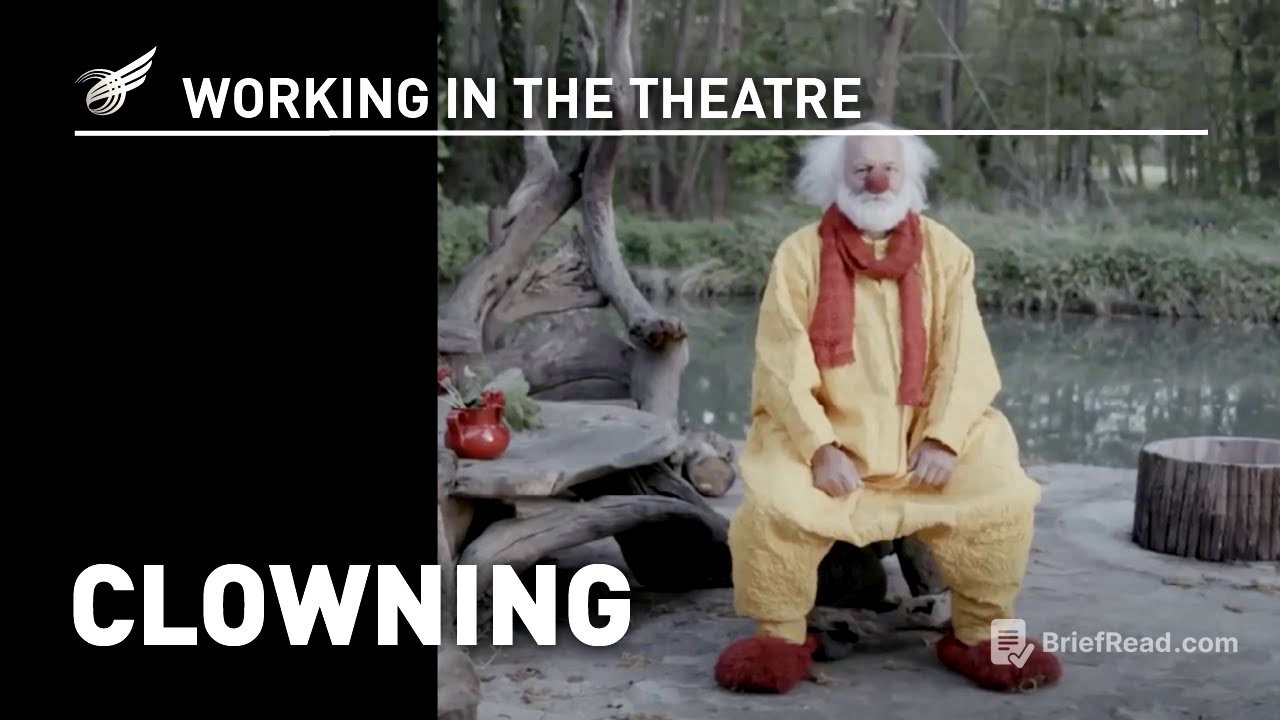TLDR;
This video explores the art of clowning, its history, techniques, and its profound connection to the human experience. It covers the role of clowns in circuses, their connection with the audience, and the different styles of clowning from physical comedy to clown theatre. The video also touches on the historical roots of clowning, its evolution through various forms of entertainment, and the emotional depth that makes it a powerful art form.
- Clowns connect with audiences through humor and empathy.
- Physical comedy is timeless and transcends language barriers.
- Clowning has evolved from street performance to theatrical art.
- Clowning transforms pain and suffering into laughter.
Entertaining Through Clowning [2:04]
The speaker expresses a lifelong passion for entertaining people through laughter and storytelling, currently fulfilled through various platforms like the stage, the ring, and even casual street interactions. They describe their current experience performing with a circus as new and exciting, highlighting the unique lifestyle of traveling, living in RV trailers, and exploring new cities. The speaker also touches on their approach to makeup, humorously comparing it to Jackson Pollock's style. Clowns serve as a vital human connection for the audience, aiming to befriend and create a memorable experience for them.
The Essence of Clowning [3:33]
The speaker shares an old adage that "a clown falls down so we don't have to," emphasizing the cathartic role of clowns in allowing people to laugh at shared realities. Inspiration for clown characters and routines comes from observing people, self-reflection, reading, and traveling. Physical jokes are considered timeless due to their lack of reliance on language, making them universally accessible, while verbal jokes can become dated due to their topical nature.
Clowning Styles and Modern Clown Theatre [5:11]
Clowning is often associated with the red nose, misfit clothes, and circuses, while theatre is linked to physical comedians. Clown theatre is a contemporary form embraced by figures like Bill Irwin and David Shiner, characterized by its metaphorical and symbolic nature. The speaker recalls being inspired by Bill Irwin's work in a video showcasing street artists, which motivated them to want to meet and collaborate with him.
Collaboration and Influence in Clowning [6:24]
The speaker praises Bill Irwin as a clown who masterfully combines theatre, dance, and clowning. They recount meeting Irwin at a Cirque du Soleil show in 1991 and later collaborating on a movie, where they discovered their great chemistry. Slava Polunin is recognized for popularizing Russian clowning internationally through his Snow Show, educating audiences and expanding the definition of what a clown can be by incorporating lyrical, metaphorical, and symbolic elements.
The Creative Process and Versatility of Clowning [9:49]
Clowns in the circus create original material tailored to their strengths, fostering constant creativity and improvisation skills. Clowns can perform in various settings, including theatre, circus, variety shows, and on the street. The intimacy of the performance space influences the subtlety of the clowning, with the performer adapting their style to suit the venue.
Historical Roots and Evolution of Clowning [12:03]
Clowning dates back to ancient Egypt and has historically been an art form of the street, accessible to the common people. Shakespeare popularized the term "clown" to describe comic relief characters. In England, Joseph Grimaldi brought clowning to the forefront of pantomimes. Clowns became central to the French circus after Napoleon outlawed social commentary elsewhere, with English pantomime clowns integrating into the circus.
Symbolism and Development of Clowning [13:13]
The red nose, initially associated with drunkenness, has evolved into a symbol of humanity and emotion. The separation of clowns into white face (symbolizing thought) and auguste (symbolizing heart) further defined the art form. The rise of circuses, pantomimes, vaudeville, and burlesque contributed to the mass popularity of clowning, with silent films providing an international platform for slapstick humor.
Learning from the Greats [14:55]
Aspiring clowns are encouraged to study the works of past masters, such as Paul Young and Felix Adler for circus props, and Buster Keaton, Charlie Chaplin, Laurel and Hardy, the Marx Brothers, and the Three Stooges for physical comedy. Emulating these influences helps clowns develop their unique style.
The Power of Clowning [18:27]
Whether as a stand-up comedian, comic actor, or circus clown, the ultimate goal is to evoke laughter or emotional connection. Clowning's power lies in its ability to address the human condition, transforming pain into laughter. It allows people to laugh about suffering, embarrassment, loneliness, and despair, making it a profound and relatable art form.









